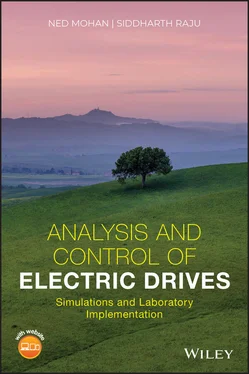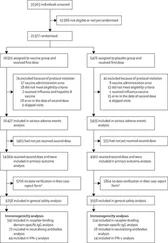7 Chapter 7Fig. 7-1 Switch‐mode inverter.Fig. 7-2 Basic voltage vectors (  and
and  not shown).Fig. 7-3 Voltage vector in Sector 1.Fig. 7-4 Waveforms in Sector 1; z = z 0 +z 7.Fig. 7-5 Simulation of Example 7-1.Fig. 7-6 Simulation results of Example 7-1.Fig. 7-7 Limit on amplitude
not shown).Fig. 7-3 Voltage vector in Sector 1.Fig. 7-4 Waveforms in Sector 1; z = z 0 +z 7.Fig. 7-5 Simulation of Example 7-1.Fig. 7-6 Simulation results of Example 7-1.Fig. 7-7 Limit on amplitude  Fig. 7-8 Real‐time three‐phase inverter (a) Sine‐PWM and (b) SV‐PWM.
Fig. 7-8 Real‐time three‐phase inverter (a) Sine‐PWM and (b) SV‐PWM.
8 Chapter 8Fig. 8-1 Characteristics of various permanent‐magnet materials.Fig. 8-2 Block diagram of the closed‐loop operation of a PMAC drive.Fig. 8-3 Two‐pole PMAC machine.Fig. 8-4 The stator current and the rotor field space vectors in PMAC drives...Fig. 8-5 Torque calculation on the stator.Fig. 8-6 Similarities between (a) dc motor and (b) PMAC motor drives.Fig. 8-7 Rotor‐load mechanical system.Fig. 8-8 Stator‐current space vector for Example 8-1.Fig. 8-9 (a) Induced emf due to rotating rotor flux‐density space vector and...Fig. 8-10 (a) Space vector diagram of induced emfs and (b) phasor diagram fo...Fig. 8-11 (a) Per‐phase equivalent circuit and (b) simplified equivalent cir...Fig. 8-12 (a) Block diagram representation of hysteresis current control and...Fig. 8-13 Real‐time PMAC motor hysteresis current control.Fig. 8-14 Hardware speed result.Fig. 8-15 Three phase stator current.
9 Chapter 9Fig. 9-1 (a) Three‐phase stator winding axes and (b) squirrel‐cage rotor.Fig. 9-2 Balanced three‐phase sinusoidal voltages applied to the stator, rot...Fig. 9-3 Space vector representations at time t = 0, (b) voltage and current...Fig. 9-4 (a) Two winding transformer and (b) equivalent circuit of the two w...Fig. 9-5 (a) Induced voltages in the rotor bar and (b) motion of the rotor b...Fig. 9-6 (a) Polarities of voltages induced and (b) electrical equivalent ci...Fig. 9-7 (a) Rotor‐produced flux  and the flux
and the flux  , and (b) space vector diag...Fig. 9-8 Rotor‐produced mmf and the compensating mmf at time t = t 1.Fig. 9-9 Example 9-2.Fig. 9-10 Voltage induced in bar “ p ” at (a) t = 0 and (b) t = t 1.Fig. 9-11 Calculation of electromagnetic torque.Fig. 9-12 Torque‐speed characteristic of induction motors.Fig. 9-13 Operation of an induction motor.Fig. 9-14 Regenerative braking in induction motors.Fig. 9-15 Example 9-5.Fig. 9-16 Reversing the direction of rotation in an induction motor.Fig. 9-17 Space vectors with the effect of rotor leakage flux included.Fig. 9-18 Rated voltage applied.Fig. 9-19 Blocked rotor and slip‐frequency voltages applied.Fig. 9-20 Splitting the rotor resistance into the loss component and power o...Fig. 9-21 (a) Per‐phase equivalent circuit including the stator leakage and ...Fig. 9-22 (a) No‐load test and (b) blocked‐rotor test.Fig. 9-23 (a) Torque‐speed characteristic and (b) current‐speed characterist...Fig. 9-24 Typical performance curves for Design B 10 kW, 4‐pole, three‐phase...Fig. 9-25 Typical torque‐speed characteristics of NEMA design A, B, C, and D...Fig. 9-26 Available acceleration torque during start‐up.
, and (b) space vector diag...Fig. 9-8 Rotor‐produced mmf and the compensating mmf at time t = t 1.Fig. 9-9 Example 9-2.Fig. 9-10 Voltage induced in bar “ p ” at (a) t = 0 and (b) t = t 1.Fig. 9-11 Calculation of electromagnetic torque.Fig. 9-12 Torque‐speed characteristic of induction motors.Fig. 9-13 Operation of an induction motor.Fig. 9-14 Regenerative braking in induction motors.Fig. 9-15 Example 9-5.Fig. 9-16 Reversing the direction of rotation in an induction motor.Fig. 9-17 Space vectors with the effect of rotor leakage flux included.Fig. 9-18 Rated voltage applied.Fig. 9-19 Blocked rotor and slip‐frequency voltages applied.Fig. 9-20 Splitting the rotor resistance into the loss component and power o...Fig. 9-21 (a) Per‐phase equivalent circuit including the stator leakage and ...Fig. 9-22 (a) No‐load test and (b) blocked‐rotor test.Fig. 9-23 (a) Torque‐speed characteristic and (b) current‐speed characterist...Fig. 9-24 Typical performance curves for Design B 10 kW, 4‐pole, three‐phase...Fig. 9-25 Typical torque‐speed characteristics of NEMA design A, B, C, and D...Fig. 9-26 Available acceleration torque during start‐up.
10 Chapter 10Fig. 10-1 Block diagram of an induction‐motor drive.Fig. 10-2 Operation characteristics with constant  .Fig. 10-3 Example 10-1.Fig. 10-4 (a) Per‐phase equivalent circuit in balanced steady state, (b) equ...Fig. 10-5 Relation of applied voltage and frequency at the rated flux densit...Fig. 10-6 Example 10-2.Fig. 10-7 Start‐up considerations in induction‐motor drives.Fig. 10-8 Capability below and above the rated speed.Fig. 10-9 Induction‐generator drives.Fig. 10-10 Speed control of induction‐motor drives.Fig. 10-11 PPU of induction‐motor drives.Fig. 10-12 (a) PPU output voltage waveforms and (b) harmonic spectrum of L‐L...Fig. 10-13 Per‐phase equivalent circuit (a) at the fundamental frequency and...Fig. 10-14 (a) Equivalent circuit for fundamental and harmonic frequencies i...Fig. 10-15 Real‐time model to obtain induction motor torque‐speed characteri...Fig. 10-16 Real‐time induction motor closed‐loop speed control.Fig. 10-17 Hardware result of closed‐loop speed control.
.Fig. 10-3 Example 10-1.Fig. 10-4 (a) Per‐phase equivalent circuit in balanced steady state, (b) equ...Fig. 10-5 Relation of applied voltage and frequency at the rated flux densit...Fig. 10-6 Example 10-2.Fig. 10-7 Start‐up considerations in induction‐motor drives.Fig. 10-8 Capability below and above the rated speed.Fig. 10-9 Induction‐generator drives.Fig. 10-10 Speed control of induction‐motor drives.Fig. 10-11 PPU of induction‐motor drives.Fig. 10-12 (a) PPU output voltage waveforms and (b) harmonic spectrum of L‐L...Fig. 10-13 Per‐phase equivalent circuit (a) at the fundamental frequency and...Fig. 10-14 (a) Equivalent circuit for fundamental and harmonic frequencies i...Fig. 10-15 Real‐time model to obtain induction motor torque‐speed characteri...Fig. 10-16 Real‐time induction motor closed‐loop speed control.Fig. 10-17 Hardware result of closed‐loop speed control.
11 Chapter 11Fig. 11-1 Stator windings.Fig. 11-2 Three‐phase windings.Fig. 11-3 Single‐phase magnetizing inductance L m,one‐phaseand leakage...Fig. 11-4 Mutual inductance L mutual.Fig. 11-5 Rotor circuit represented by three‐phase windings.Fig. 11-6 Space vector representation of various mmf quantities.Fig. 11-7 Physical interpretation of stator current space vector.Fig. 11-8 Relationship between space vector and phasor in sinusoidal steady ...Fig. 11-9 All stator space vectors are collinear (rotor open‐circuited).Fig. 11-10 All rotor space vectors are collinear (stator open‐circuited).
12 Chapter 12Fig. 12-1 Representation of stator mmf by equivalent dq ‐windings.Fig. 12-2 Representation of rotor mmf by equivalent dq ‐winding currents.Fig. 12-3 Stator and rotor representation by equivalent dq ‐winding currents....Fig. 12-4 Transformation of phase quantities into dq ‐winding quantities: (a)...Fig. 12-5 Stator αβ and dq equivalent windings.Fig. 12-6 Rotor αβ and dq equivalent windings.Fig. 12-7 Calculating dq ‐winding flux linkages and currents.Fig. 12-8 Torque on the rotor d ‐axis.Fig. 12-9 Torque on the rotor q ‐axis.Fig. 12-10 dq ‐winding equivalent circuits: (a) d ‐axis and (b) q ‐axis.Fig. 12-11 Per‐phase equivalent circuit in steady state.Fig. 12-12 Induction motor model in terms of dq ‐windings.Fig. 12-13 Simulation of Example 12-3.Fig. 12-14 Simulation results of Example 12-3.
13 Chapter 13Fig. 13-1 Stator and the rotor mmf representations by equivalent dq winding ...Fig. 13-2 Dynamic circuits with the d ‐axis aligned with  .Fig. 13-3 The d ‐axis circuit simplified with a current excitation.Fig. 13-4 Motor model with d ‐axis aligned with
.Fig. 13-3 The d ‐axis circuit simplified with a current excitation.Fig. 13-4 Motor model with d ‐axis aligned with  .Fig. 13-5 Simulations of Example 13-1.Fig. 13-6 Results of Example 13-1.Fig. 13-7 Vector‐controlled induction motor with a CR‐PWM inverter.Fig. 13-8 Vector‐controlled induction motor drive with a current‐regulated P...Fig. 13-9 Design of the speed‐loop controller.Fig. 13-10 Simulation of Example 13-2.Fig. 13-11 Results of Example 13-2.Fig. 13-12 Vector control with applied voltages.Fig. 13-13 Design of the current‐loop controller.Fig. 13-14 Simulation of Example 13-3.Fig. 13-15 Simulation results of Example 13-3.Fig. 13-16 Real‐time induction motor vector control.Fig. 13-17 Simulation versus hardware speed result.Fig. 13-18 Estimated torque versus load torque in hardware.
.Fig. 13-5 Simulations of Example 13-1.Fig. 13-6 Results of Example 13-1.Fig. 13-7 Vector‐controlled induction motor with a CR‐PWM inverter.Fig. 13-8 Vector‐controlled induction motor drive with a current‐regulated P...Fig. 13-9 Design of the speed‐loop controller.Fig. 13-10 Simulation of Example 13-2.Fig. 13-11 Results of Example 13-2.Fig. 13-12 Vector control with applied voltages.Fig. 13-13 Design of the current‐loop controller.Fig. 13-14 Simulation of Example 13-3.Fig. 13-15 Simulation results of Example 13-3.Fig. 13-16 Real‐time induction motor vector control.Fig. 13-17 Simulation versus hardware speed result.Fig. 13-18 Estimated torque versus load torque in hardware.
14 Chapter 14Fig. 14-1 Open‐loop ω mechand  position estimator.Fig. 14.2 Simulation of Example 14-1. (a) Overall Simulink model and (b) ope...Fig. 14-3 Results of Example 14-1.Fig. 14-4 MRAS ω mand
position estimator.Fig. 14.2 Simulation of Example 14-1. (a) Overall Simulink model and (b) ope...Fig. 14-3 Results of Example 14-1.Fig. 14-4 MRAS ω mand  position estimator.Fig. 14‐5 MRAS θ daand
position estimator.Fig. 14‐5 MRAS θ daand  determination.Fig. 14-6 Simulation of Example 14-2 MRAS estimator.Fig. 14-7 Results of Example 14-2.Fig. 14-8 MRAS estimator linearized system transfer function.Fig. 14-9 Simulation of Example 14-4: open‐speed estimator effect of paramet...Fig. 14-10 Simulation of Example 14-4: MRAS estimator effect of parameter va...Fig. 14-11 Bode plot of an ideal and practical integrator.Fig. 14-12 Bode plot of an ideal and practical differentiator.
determination.Fig. 14-6 Simulation of Example 14-2 MRAS estimator.Fig. 14-7 Results of Example 14-2.Fig. 14-8 MRAS estimator linearized system transfer function.Fig. 14-9 Simulation of Example 14-4: open‐speed estimator effect of paramet...Fig. 14-10 Simulation of Example 14-4: MRAS estimator effect of parameter va...Fig. 14-11 Bode plot of an ideal and practical integrator.Fig. 14-12 Bode plot of an ideal and practical differentiator.
Читать дальше

 and
and  not shown).Fig. 7-3 Voltage vector in Sector 1.Fig. 7-4 Waveforms in Sector 1; z = z 0 +z 7.Fig. 7-5 Simulation of Example 7-1.Fig. 7-6 Simulation results of Example 7-1.Fig. 7-7 Limit on amplitude
not shown).Fig. 7-3 Voltage vector in Sector 1.Fig. 7-4 Waveforms in Sector 1; z = z 0 +z 7.Fig. 7-5 Simulation of Example 7-1.Fig. 7-6 Simulation results of Example 7-1.Fig. 7-7 Limit on amplitude  Fig. 7-8 Real‐time three‐phase inverter (a) Sine‐PWM and (b) SV‐PWM.
Fig. 7-8 Real‐time three‐phase inverter (a) Sine‐PWM and (b) SV‐PWM. and the flux
and the flux  , and (b) space vector diag...Fig. 9-8 Rotor‐produced mmf and the compensating mmf at time t = t 1.Fig. 9-9 Example 9-2.Fig. 9-10 Voltage induced in bar “ p ” at (a) t = 0 and (b) t = t 1.Fig. 9-11 Calculation of electromagnetic torque.Fig. 9-12 Torque‐speed characteristic of induction motors.Fig. 9-13 Operation of an induction motor.Fig. 9-14 Regenerative braking in induction motors.Fig. 9-15 Example 9-5.Fig. 9-16 Reversing the direction of rotation in an induction motor.Fig. 9-17 Space vectors with the effect of rotor leakage flux included.Fig. 9-18 Rated voltage applied.Fig. 9-19 Blocked rotor and slip‐frequency voltages applied.Fig. 9-20 Splitting the rotor resistance into the loss component and power o...Fig. 9-21 (a) Per‐phase equivalent circuit including the stator leakage and ...Fig. 9-22 (a) No‐load test and (b) blocked‐rotor test.Fig. 9-23 (a) Torque‐speed characteristic and (b) current‐speed characterist...Fig. 9-24 Typical performance curves for Design B 10 kW, 4‐pole, three‐phase...Fig. 9-25 Typical torque‐speed characteristics of NEMA design A, B, C, and D...Fig. 9-26 Available acceleration torque during start‐up.
, and (b) space vector diag...Fig. 9-8 Rotor‐produced mmf and the compensating mmf at time t = t 1.Fig. 9-9 Example 9-2.Fig. 9-10 Voltage induced in bar “ p ” at (a) t = 0 and (b) t = t 1.Fig. 9-11 Calculation of electromagnetic torque.Fig. 9-12 Torque‐speed characteristic of induction motors.Fig. 9-13 Operation of an induction motor.Fig. 9-14 Regenerative braking in induction motors.Fig. 9-15 Example 9-5.Fig. 9-16 Reversing the direction of rotation in an induction motor.Fig. 9-17 Space vectors with the effect of rotor leakage flux included.Fig. 9-18 Rated voltage applied.Fig. 9-19 Blocked rotor and slip‐frequency voltages applied.Fig. 9-20 Splitting the rotor resistance into the loss component and power o...Fig. 9-21 (a) Per‐phase equivalent circuit including the stator leakage and ...Fig. 9-22 (a) No‐load test and (b) blocked‐rotor test.Fig. 9-23 (a) Torque‐speed characteristic and (b) current‐speed characterist...Fig. 9-24 Typical performance curves for Design B 10 kW, 4‐pole, three‐phase...Fig. 9-25 Typical torque‐speed characteristics of NEMA design A, B, C, and D...Fig. 9-26 Available acceleration torque during start‐up. .Fig. 10-3 Example 10-1.Fig. 10-4 (a) Per‐phase equivalent circuit in balanced steady state, (b) equ...Fig. 10-5 Relation of applied voltage and frequency at the rated flux densit...Fig. 10-6 Example 10-2.Fig. 10-7 Start‐up considerations in induction‐motor drives.Fig. 10-8 Capability below and above the rated speed.Fig. 10-9 Induction‐generator drives.Fig. 10-10 Speed control of induction‐motor drives.Fig. 10-11 PPU of induction‐motor drives.Fig. 10-12 (a) PPU output voltage waveforms and (b) harmonic spectrum of L‐L...Fig. 10-13 Per‐phase equivalent circuit (a) at the fundamental frequency and...Fig. 10-14 (a) Equivalent circuit for fundamental and harmonic frequencies i...Fig. 10-15 Real‐time model to obtain induction motor torque‐speed characteri...Fig. 10-16 Real‐time induction motor closed‐loop speed control.Fig. 10-17 Hardware result of closed‐loop speed control.
.Fig. 10-3 Example 10-1.Fig. 10-4 (a) Per‐phase equivalent circuit in balanced steady state, (b) equ...Fig. 10-5 Relation of applied voltage and frequency at the rated flux densit...Fig. 10-6 Example 10-2.Fig. 10-7 Start‐up considerations in induction‐motor drives.Fig. 10-8 Capability below and above the rated speed.Fig. 10-9 Induction‐generator drives.Fig. 10-10 Speed control of induction‐motor drives.Fig. 10-11 PPU of induction‐motor drives.Fig. 10-12 (a) PPU output voltage waveforms and (b) harmonic spectrum of L‐L...Fig. 10-13 Per‐phase equivalent circuit (a) at the fundamental frequency and...Fig. 10-14 (a) Equivalent circuit for fundamental and harmonic frequencies i...Fig. 10-15 Real‐time model to obtain induction motor torque‐speed characteri...Fig. 10-16 Real‐time induction motor closed‐loop speed control.Fig. 10-17 Hardware result of closed‐loop speed control. .Fig. 13-3 The d ‐axis circuit simplified with a current excitation.Fig. 13-4 Motor model with d ‐axis aligned with
.Fig. 13-3 The d ‐axis circuit simplified with a current excitation.Fig. 13-4 Motor model with d ‐axis aligned with  .Fig. 13-5 Simulations of Example 13-1.Fig. 13-6 Results of Example 13-1.Fig. 13-7 Vector‐controlled induction motor with a CR‐PWM inverter.Fig. 13-8 Vector‐controlled induction motor drive with a current‐regulated P...Fig. 13-9 Design of the speed‐loop controller.Fig. 13-10 Simulation of Example 13-2.Fig. 13-11 Results of Example 13-2.Fig. 13-12 Vector control with applied voltages.Fig. 13-13 Design of the current‐loop controller.Fig. 13-14 Simulation of Example 13-3.Fig. 13-15 Simulation results of Example 13-3.Fig. 13-16 Real‐time induction motor vector control.Fig. 13-17 Simulation versus hardware speed result.Fig. 13-18 Estimated torque versus load torque in hardware.
.Fig. 13-5 Simulations of Example 13-1.Fig. 13-6 Results of Example 13-1.Fig. 13-7 Vector‐controlled induction motor with a CR‐PWM inverter.Fig. 13-8 Vector‐controlled induction motor drive with a current‐regulated P...Fig. 13-9 Design of the speed‐loop controller.Fig. 13-10 Simulation of Example 13-2.Fig. 13-11 Results of Example 13-2.Fig. 13-12 Vector control with applied voltages.Fig. 13-13 Design of the current‐loop controller.Fig. 13-14 Simulation of Example 13-3.Fig. 13-15 Simulation results of Example 13-3.Fig. 13-16 Real‐time induction motor vector control.Fig. 13-17 Simulation versus hardware speed result.Fig. 13-18 Estimated torque versus load torque in hardware. position estimator.Fig. 14.2 Simulation of Example 14-1. (a) Overall Simulink model and (b) ope...Fig. 14-3 Results of Example 14-1.Fig. 14-4 MRAS ω mand
position estimator.Fig. 14.2 Simulation of Example 14-1. (a) Overall Simulink model and (b) ope...Fig. 14-3 Results of Example 14-1.Fig. 14-4 MRAS ω mand  position estimator.Fig. 14‐5 MRAS θ daand
position estimator.Fig. 14‐5 MRAS θ daand  determination.Fig. 14-6 Simulation of Example 14-2 MRAS estimator.Fig. 14-7 Results of Example 14-2.Fig. 14-8 MRAS estimator linearized system transfer function.Fig. 14-9 Simulation of Example 14-4: open‐speed estimator effect of paramet...Fig. 14-10 Simulation of Example 14-4: MRAS estimator effect of parameter va...Fig. 14-11 Bode plot of an ideal and practical integrator.Fig. 14-12 Bode plot of an ideal and practical differentiator.
determination.Fig. 14-6 Simulation of Example 14-2 MRAS estimator.Fig. 14-7 Results of Example 14-2.Fig. 14-8 MRAS estimator linearized system transfer function.Fig. 14-9 Simulation of Example 14-4: open‐speed estimator effect of paramet...Fig. 14-10 Simulation of Example 14-4: MRAS estimator effect of parameter va...Fig. 14-11 Bode plot of an ideal and practical integrator.Fig. 14-12 Bode plot of an ideal and practical differentiator.










